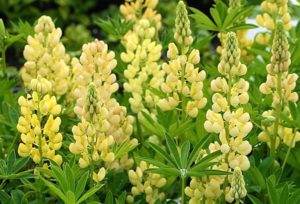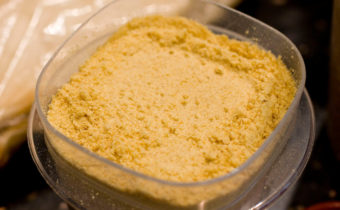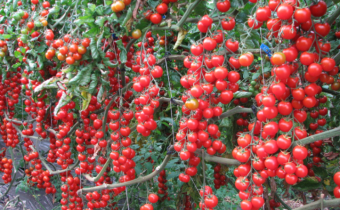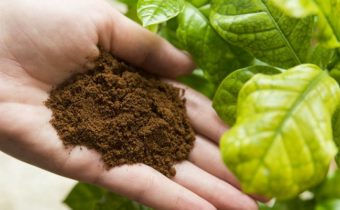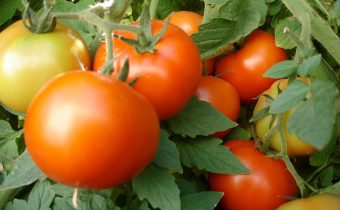10 ways to return soil fertility

Hardworking gardeners constantly care about the quality of the land on their plots, but over time they notice that the yield of vegetables and fruits falls. The reason for this is one - the earthen substrate in their beds is gradually depleted. What factors lead to such a condition of the soil, how to prepare the soil in the fall for spring plantings, and eliminate the shortcomings that lead to lower yields? There are 10 ways to heal and restore impoverished humus.
-
Signs of soil depletion and problem solving
- Symptom 1: the fertile humus became thinner
- Symptom 2: the soil is depleted and turns into dust
- Symptom 3: the soil is overly compacted
- Symptom 4: the fertile soil layer is infected with diseases and pests
- Symptom 5: Soil Salt Exceeded
- Symptom 6: a lot of alkali in the soil
- Symptom 7: the level of acidity of the soil above the norm
- Symptom 8: a rusty patina forms on the soil
- Symptom 9: fertile ground covered with moss
- Symptom 10: soil structure is damaged by frequent digging
- Conclusion
Signs of soil depletion and problem solving
Earth is a source of nutrients. From the upper fertile layer of soil to the plants water and trace elements necessary for their normal growth and fruiting. Violations of the rules of agricultural engineering and the wrong approach to the cultivation of land lead to the rapid depletion of humus. This situation should be rectified immediately, it should be made more convenient in the autumn, when the entire crop has been harvested and there are no obstacles for improving the quality of the substrate in the beds.
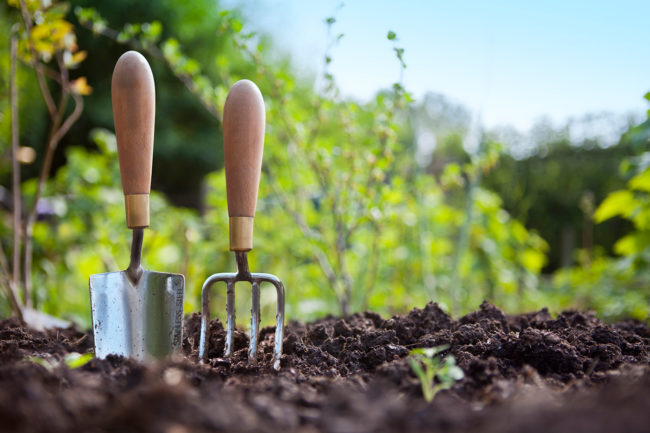
Symptom 1: the fertile humus became thinner
A layer of earth containing humic and humic acids is called humus. The thicker the gasket, the more fertile the soil. Plants need constant feeding, if organic fertilizers are not applied in a timely manner, then the organic matter is washed out and compacted. Nutrients come to the plants and this impoverishes the substrate.
In the autumn period, the beds freed from the fruit are improved by several methods:
- Bring in the soil compost at the rate of 2-3 buckets per 1 m2 and they dig up a plot.
- Plant-green manure sowed in depleted areas that can enrich the humus layer with useful trace elements and improve the structure of the earth. For each culture should be selected suitable companions. Lupine sown in the beds, where the spring provides for the planting of cucumbers or zucchini, tomatoes, peppers or eggplants. Mustard helps to get rid of nematodes and improves the soil for growing potatoes. Rape will serve as a good sideratom for sowing carrots and beets, protects the humus from the appearance of fungi. Alfalfa, peas, beans and beans increase the nitrogen content in the soil.
- In the spring, plants are planted on a thinned layer of humus with deeply penetrating roots capable of extracting useful substances at great depths.
Organic fertilizers need to be laid in the fall in moderation, excessive use of fresh manure, bird droppings causes a substrate oversaturation with nitrogen, which adversely affects the development of plants and can destroy them.
Symptom 2: the soil is depleted and turns into dust
Proponents of growing organic fruit crops try not to use organic matter and mineral fertilizers. They remove the weed grass with frequent digging and loosening the beds, forgetting or ignoring the mulching.As a result of such actions, after a while the earth becomes very loose, it is easily washed away by rains, it completely lacks minerals and other nutrients absorbed by plants over several years.
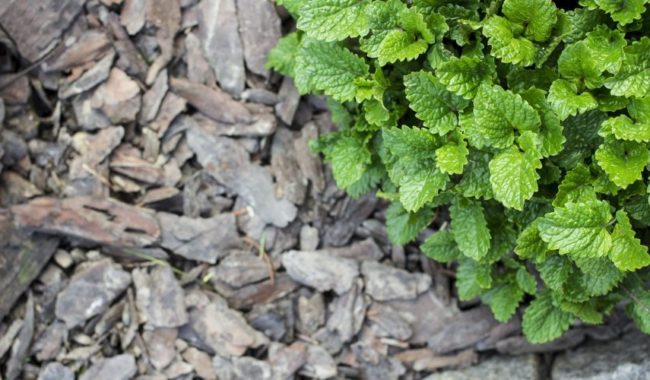
In the autumn, the structure of such a “light” soil should be improved; otherwise, do not expect good harvests next season. You can correct this situation by completing several events:
- An expensive way is to remove the top layer of the earth, replace it with a substrate enriched with organic matter and mineral fertilizers.
- Inexpensive, but time consuming method - remove the layer of earth 10 cm deep, pour natural compost on this site, dig, leaving large clods of earth not broken, put the removed soil on top. During the winter, under the influence of snow and frost, large clumps will collapse, and the light soil will harden.
- The easiest method is to control weeds with mulch: straw, rotted compost, fresh cut grass. In the autumn, this natural covering of the beds is buried in the ground, and in spring and summer it will be a source of food for the newly planted plants.
Symptom 3: the soil is overly compacted
The reasons for the hardening of the upper layer of the soil are heavy loamy areas and violations of the processing technology of such a soil. It will require a special approach to digging the beds. You can not carry out such work immediately after the rain. Wet loam, in this case, will be at the top, forming a dense crust on the surface, which does not pass well to the water and air needed by the roots of plants.
Autumn on loam soil ennoble:
- loosen the earth to a depth of 10 cm, but the clods are not crushed, the frost and cold will destroy their structure;
- high clay content is reduced by adding river coarse sand of 1 bucket per 1 m2;
- ground worms are crushed, but to attract them to the site, special conditions are needed: a small thickness of the compost layer (5-10 cm) or an infusion of dandelions. The roots and stems of the plant (900 g) brew in boiling water (10 l) and insist 2 weeks. Dilute the infusion at a rate of 1:10, water the soil. If you have absolutely no such assistants on the site, there is a way out - buy in a store (Californian worms) or dig in a dung heap from a neighbor.
It is possible to avoid soil compaction in the beds by arranging the drainage system of the drainage system. Large areas of dachas and backyards are drained by building deep ditches, filling them with rubble or broken bricks. Drainage of small beds with heavy soil is made by digging out shallow grooves with a 15 degree bias to one side.
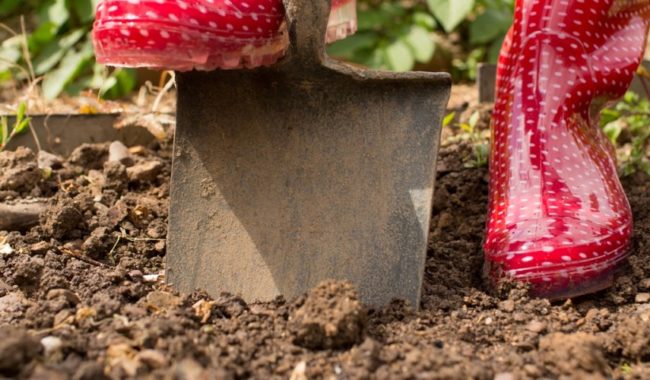
Symptom 4: the fertile soil layer is infected with diseases and pests
Let us briefly return to what was said earlier, that is, to the cultivation of fruits and vegetables in environmentally friendly conditions. This method denies the use of pesticides in gardens and cities to protect plants from diseases and pests.
Permissible folk remedies, however, are not as effective as chemicals. As a result, gardeners often complain of the widespread fungal and viral diseases of plant crops. Pests, too, are not asleep, they attack defenseless plants and devour them, which leads to the loss of a significant part of the crop.
Improvement of the land is best done in the fall. At this time of the year, all the roots have been dug out and other vegetables have been removed from the beds, so there is no danger of damaging the fruits during the application of chemicals. It is necessary to treat the earth, having executed a complex of actions - it is agrotechnical processing, biological and chemical protection.
Tillage in the fall
Agricultural technology is a deep digging of the earth to improve aeration, that is, evaporation of excess moisture, because the reproduction of fungi occurs in a humid environment. This also applies to the observance of the rules of crop rotation, it is impossible to plant the same culture in one place for more than 1 year.
Mycelium of the fungus, which affects a certain type of plant, dies for 3-5 years, only after that you can return everything to its original place. Planting and sowing need clean, that is, decontaminated seeds and seedlings. Weed grass in infected areas should be removed and disposed of in a timely manner.

Biological soil improvement
A small territory of the summer cottage is treated with biological products that are safe for people and animals. 3-4 weeks before the autumn frosts, the soil is sprayed with solutions of such drugs as Baikal EM-1 or EM-5, as well as biological fungicides Trichodermin, Baktofit or Planzir.
Biological treatment of humus must be carried out twice. In autumn - in October, November, and in spring - in the end of February, the beginning of March.
Emergency measures - chemical exposure
Agrotechnology and biological products can be ineffective measures against diseases and pests, then chemistry is indispensable. The safest chemicals are grade 3-4, select these and safely treat the soil:
- in the fall, spray or pour contaminated land with a solution of Bordeaux liquid of 3% concentration;
- in the spring (April), spill the areas with copper oxychloride (4% concentration) or use Oxyh;
- Introduce Hom, Bravo, Quadris before each well or furrow. The quantity and concentration of solutions should be specified in the instructions attached to the package.
Chemicals affect not only fungal infections and destroy viruses. They can adversely affect the entire microflora of the soil. Be careful, read the manufacturer's recommendations, do not exceed the dose and concentration of solutions.
Symptom 5: Soil Salt Exceeded
The main problem of saline land plots is the soil that is poorly washed by rain and watering. Such lands are called salt marshes. In the middle latitudes of Russia, they are rare. It rains frequently in these regions, and salt is washed off into deep layers of soil, where the roots of cultivated plants do not germinate. In the south, saline lands are often found due to climatic conditions. The sun quickly dries the surface, and it rains much less. Salt stagnates in the fertile layer and worsens its condition.
The application of mineral fertilizers and irrigation with salt water also lead to the accumulation of salt in the soil. Plants do not develop normally in salt marshes, and almost do not bear fruit. To derive excess salt deposits in two effective ways:
- Landing sideratov. Such plants as sorghum, alfalfa and Sudanese grass, adjacent to the beds with cultivated vegetables and fruits, absorb much more salt and help cleanse saline land.
- Gypsum soil. This procedure is best done in the fall, when the evaporation of moisture is minimal, because the hot summer days have passed. Salt pans sprinkled with plaster at the rate of 250-300 g per 1 m2, carefully dig. After 2 weeks the site is poured with plenty of water to salt washed into the deeper layers of the soil.
The digging should be carried out so that the gypsum mixes with the ground, as best as possible, therefore they do not use a shovel, but tillers and cultivators.
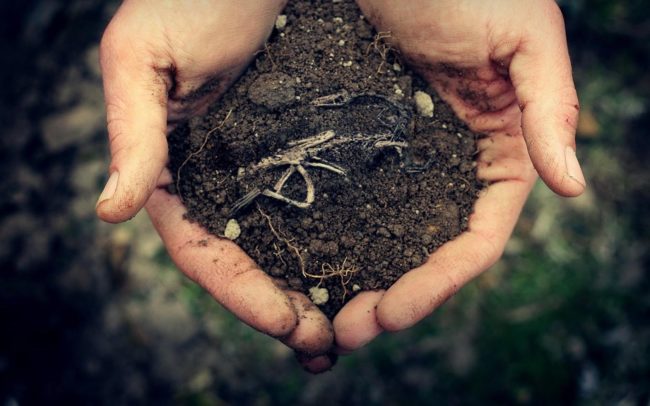
Symptom 6: a lot of alkali in the soil
Soil, in which there is a lot of alkali (calcium salts), has a low fertility. These are usually heavy rocky and clayey areas. They are poorly absorbed water, almost do not allow oxygen to the roots of plants. The level of alkalization of the earth determine the indicators of acid-base balance (pH). A figure above 8 units means that the soil is strongly alkaline. On beds with such soil, do not expect good yields.
Reduce the level of alkalization of the soil, and thus increase it aciditycan be in the fall.This is a good time for digging the garden and preparing the beds for spring planting. At the end of September, the following activities must be carried out:
- add calcium sulphate (gypsum) or granulated sulfur to the soil, which improves the soil structure;
- produce deep mechanized plowing;
- process the soil solution of ferrous sulfate.
Mineral substances should be introduced gradually, no more than once a year. The results of a decrease in soil alkalization can be seen next season, or even 2-4 years later.
Symptom 7: the level of acidity of the soil above the norm
The hydrogen ions present in the soil in large quantities stimulate the formation of chemical compounds that are not available for absorption by plants. The soil acidity is determined by the number of free ions, the pH value in this case can be higher than 8 or 9, normal, that is, neutral soil, should have a value not higher than 6-7 units.
Want to get high yields from your garden beds? We'll have to work hard and reduce the acidity of the fertile layer. Spend all the activities after harvesting, this is suitable for September or early October. All work can be alternated, for example, in the fall, apply liming or the introduction of wood ash, and in the spring - planting green manure:
- The introduction of lime is carried out every 5-6 years on heavy soils and not more often than in 3-4 years on lighter areas. Lime powder is spread evenly throughout the territory in the amount of 450-700 g per 1 sq. Km. meter, it is better to do this before the rain or shed the soil with water.
- The introduction of ash from the burning of plant waste and firewood is also produced in the fall. It will be enough to spray up to 600 g of powder per 1 m2 at a time, pour it on, and in 2-3 days to dig up the entire treated area. Fertilizers, in this case, must be applied in spring. The simultaneous use of organic matter, mineral fertilizers and ash stimulates the formation of chemical compounds that are difficult to reach for the plants.
- Landing sideratov. We have already talked about the benefits of these related plants. They deoxidize the soil, normalize acidity, serve as an additional feeding. The soil is well deoxidized: alfalfa, vetch, canola, legumes, rye and oats.
During the autumn digging of the territory of the garden and vegetable garden, the siderats mow and close up to the soil to a depth of 20-30 cm. Gradually, the land for growing vegetable crops becomes loose and soft. It well passes water and the oxygen necessary for roots of plants.
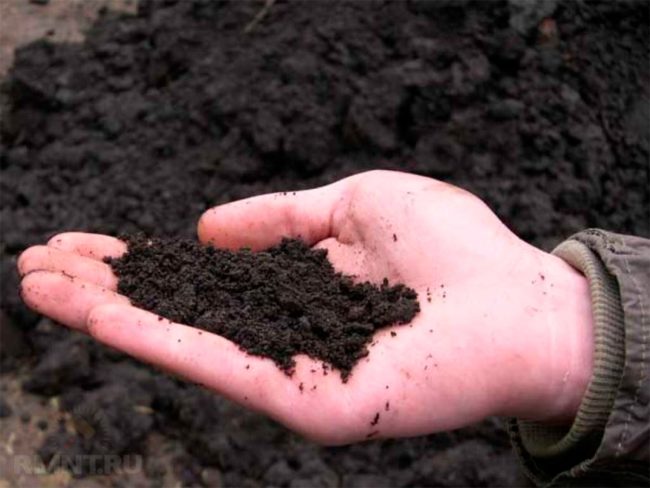
Symptom 8: a rusty patina forms on the soil
Rust on the surface of the soil appears when used for watering plants hard water. This suggests a high content of iron in it. This "veil" can talk about the appearance of fungus in the substrate.
It is possible to restore the normal condition of the land, if you follow the rules of caring for plants, namely:
- Do not water the beds with high content of iron and chlorine;
- for watering the garden use a thawed or rainwater;
- if the fungus does appear, in the fall, treat the land with fungicides (Fitosporin-M or similar means).
Chlorine contained in tap water can destroy not only harmful, but also beneficial microbes. For the preparation of chemical solutions need water, settled for at least 24 hours, so that all the chlorine had time to evaporate.
Symptom 9: fertile ground covered with moss
The moss can appear on excessively wetted areas shaded by the sun, or on strongly acidified soils.
The reasons for this situation are eliminated in the fall, and during the summer there are areas where it is necessary to carry out the following activities:
- Dig drainage ditches to drain excess water.
- On plants shaded by tall trees, plant plants that love shade. Thus, you will not leave free space, the moss will simply have nowhere to grow.
- On the beds, remove the moss by hand and spill the soil with a solution of ferrous sulfate: add about 90 ml of the preparation to 20 liters of water.
Moss is often used for decorating lawns and garden paths. Spending a little time and putting a little imagination, you can independently make a unique composition.
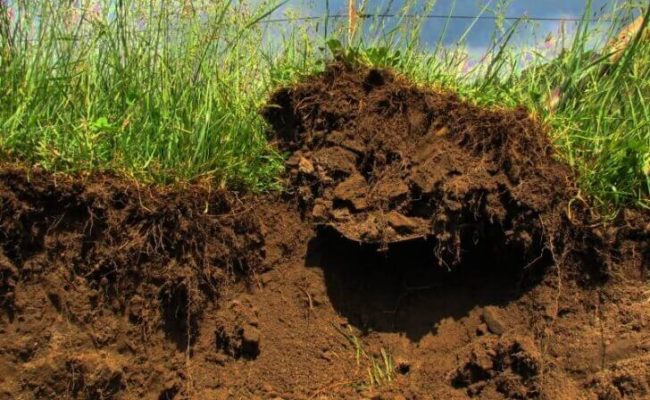
Symptom 10: soil structure is damaged by frequent digging
Gardeners, trying to improve the condition of the soil in their summer cottages, “shovel” the ground in spring and autumn. Such zeal often leads to the opposite effect - the soil structure changes, it becomes unsuitable for cultivation of cultivated plants. The upper fertile layer of the earth constantly appears below, the microflora is disturbed.
Many experienced gardeners refused to dig up the beds, thereby keeping the fertile layer intact. Maybe we should give the earth a rest, recover, be filled with useful substances in order to direct life-giving juices to the plants?
Skip the deep digging this year, try to loosen the earth with a regular hoe. The depth of its penetration is small, only 10-15 cm, but such processing does not violate the structure of the soil and does not destroy the established microflora.
Conclusion
Caring gardeners for the restoration of damaged soil - these are timely measures aimed at increasing yields, it is time-consuming work that can not be called useless. Gardens and orchards, after refining the land, will respond with a bountiful harvest of fruits and vegetables.

